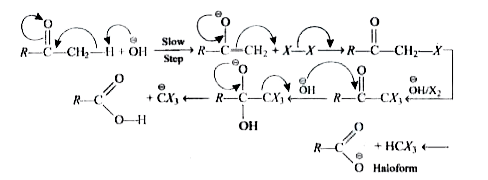In the following reaction product 'P' is
R−O∣∣C−ClH2−−−→BaSO4P.
RCH2OH
RCOOH
RCHO
RCH3
The correct Answer is:C
To solve the question regarding the product 'P' formed in the reaction of R-C(=O)Cl with H2 in the presence of BaSO4, we can follow these steps:
Step 1: Identify the Reactants
The reactant in the reaction is an acid chloride, which can be represented as R-C(=O)Cl. Here, R represents an alkyl or aryl group.
Hint: Recognize that acid chlorides are derivatives of carboxylic acids and are reactive due to the presence of the chlorine atom.
Step 2: Understand the Reaction Conditions
The reaction is carried out in the presence of hydrogen gas (H2) and a catalyst, which is palladium on barium sulfate (Pd/BaSO4). This combination indicates that the reaction is likely a Rosenmund reduction.
Hint: The Rosenmund reduction specifically involves the reduction of acid chlorides to aldehydes using hydrogen gas and a palladium catalyst.
Step 3: Predict the Reaction Outcome
In the Rosenmund reduction, the chlorine atom in the acid chloride (R-C(=O)Cl) is replaced by a hydrogen atom, resulting in the formation of an aldehyde (R-CHO).
Hint: Remember that the chlorine atom is replaced by hydrogen during the reduction process, leading to the formation of an aldehyde.
Step 4: Write the Product
The product 'P' formed from the reaction of R-C(=O)Cl with H2 in the presence of Pd/BaSO4 is R-CHO, which is the general formula for an aldehyde.
Hint: Aldehydes have the functional group -CHO, which is characteristic of their structure.
Step 5: Identify the By-Product
Along with the formation of the aldehyde, hydrogen chloride (HCl) is produced as a by-product of the reaction.
Hint: Always consider the by-products formed during chemical reactions, especially when halogens are involved.
Conclusion
The product 'P' in the given reaction is R-CHO, which is an aldehyde.
Final Answer
The correct answer is that the product 'P' is an aldehyde, represented as R-CHO.
---
The reactant in the reaction is an acid chloride, which can be represented as R-C(=O)Cl. Here, R represents an alkyl or aryl group.
The reaction is carried out in the presence of hydrogen gas (H2) and a catalyst, which is palladium on barium sulfate (Pd/BaSO4). This combination indicates that the reaction is likely a Rosenmund reduction.
In the Rosenmund reduction, the chlorine atom in the acid chloride (R-C(=O)Cl) is replaced by a hydrogen atom, resulting in the formation of an aldehyde (R-CHO).
The product 'P' formed from the reaction of R-C(=O)Cl with H2 in the presence of Pd/BaSO4 is R-CHO, which is the general formula for an aldehyde.
Along with the formation of the aldehyde, hydrogen chloride (HCl) is produced as a by-product of the reaction.
The product 'P' in the given reaction is R-CHO, which is an aldehyde.
The correct answer is that the product 'P' is an aldehyde, represented as R-CHO.
Topper's Solved these Questions
- ALDEHYDES, KETONES AND CARBOXYLIC ACIDSBOOK - ICSECHAPTER - ALDEHYDES, KETONES AND CARBOXYLIC ACIDSEXERCISE - EXERCISE (PART-II DESCRIPTIVE QUESTIONS) (VERY SHORT QUESTIONS)
282 Videos
- ALDEHYDES, KETONES AND CARBOXYLIC ACIDSBOOK - ICSECHAPTER - ALDEHYDES, KETONES AND CARBOXYLIC ACIDSEXERCISE - EXERCISE (PART-II DESCRIPTIVE QUESTIONS) ( SHORT QUESTIONS)
581 Videos
- ALDEHYDES, KETONES AND CARBOXYLIC ACIDSBOOK - ICSECHAPTER - ALDEHYDES, KETONES AND CARBOXYLIC ACIDSEXERCISE - EXERCISE (PART-II DESCRIPTIVE QUESTIONS) ( LONG ANSWER QUESTIONS)
478 Videos
- ALCOHOLS, PHENOLS AND ETHERS BOOK - ICSECHAPTER - ALCOHOLS, PHENOLS AND ETHERS EXERCISE - ISC EXAMINATION QUESTIONS
25 Videos
- APPENDIX II ( TYPICAL CONVERSIONS)BOOK - ICSECHAPTER - APPENDIX II ( TYPICAL CONVERSIONS)EXERCISE - AROMATIC CONVERSIONS
98 Videos
Similar Questions
Knowledge Check
In the following reacton, product P is
R−O∣∣C−ClH2−−−−−−→Pd−BaSO4PARCHOBRCH3CRCOOHDRCH2OHCompound having −O∣∣C−CH3 group reacts rapidly with halogen in presence of a base to form haloform. The reaction is known as haloform.
R−O∣∣C−CH3X2+ϴOH−−−−→R−O∣∣C−ϴO+CHX3
Mechanism

Consider the following reactions:
Reaction I →Ph−O∣∣C−CH3Cl2,ϴOH−−−−→Ph−O∣∣C−ϴO+CHCl3
Reaction II →Ph−O∣∣C−CD3−Cl2,ϴOH−−−−→Ph−O∣∣C−ϴO+CDCl3
Which of the following is correct comparison of the rate of reaction I and II?ArI>rIIBrI>rIICrI=rIIDCannot be determinedWhich is the major product of the following reaction ?
CH3−O∣∣C−ClH2S−−→productACH3−OH∣C∣SH−ClBCH3−O∣∣C−SHCCH3−S∣∣C−ClDCH3−O∣∣C−S−O∣∣C−CH3
The major product formed in the reaction
CH3CH=CH−O∣∣C−CH3NaBH4−−−−−−−−→H2O,CH3OH is
View SolutionWrite the systematic IUPAC names of the following compounds :
H−O∣∣C−O∣∣C−H
View SolutionPredict product of following reaction,
H3C−O∣∣C−O−C2H5NaBH4−−−−→
View SolutionFind the product of following reaction
2CH3CH2−O∣∣C−OC2H5C2H5ϴO−−−−−−→H⊕3O(X)
X will be
View SolutionFind the product of following reaction:
Ph−CH2−O∣∣C−CH2−Ph+Ph−O∣∣C−O∣∣C−PhNaOH−−−−−−→Δ
View Solution
